Information injection-pump assembly
BOSCH
9 400 612 263
9400612263
ZEXEL
101606-0240
1016060240
ISUZU
1156034120
1156034120
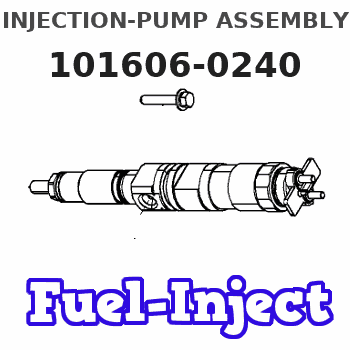
Rating:
Service parts 101606-0240 INJECTION-PUMP ASSEMBLY:
1.
_
7.
COUPLING PLATE
8.
_
9.
_
11.
Nozzle and Holder
1-15300-307-3
12.
Open Pre:MPa(Kqf/cm2)
18.1{185}/22.1{225}
15.
NOZZLE SET
Include in #1:
101606-0240
as INJECTION-PUMP ASSEMBLY
Include in #2:
104701-1003
as _
Cross reference number
BOSCH
9 400 612 263
9400612263
ZEXEL
101606-0240
1016060240
ISUZU
1156034120
1156034120
Zexel num
Bosch num
Firm num
Name
Calibration Data:
Adjustment conditions
Test oil
1404 Test oil ISO4113 or {SAEJ967d}
1404 Test oil ISO4113 or {SAEJ967d}
Test oil temperature
degC
40
40
45
Nozzle and nozzle holder
105780-8140
Bosch type code
EF8511/9A
Nozzle
105780-0000
Bosch type code
DN12SD12T
Nozzle holder
105780-2080
Bosch type code
EF8511/9
Opening pressure
MPa
17.2
Opening pressure
kgf/cm2
175
Injection pipe
Outer diameter - inner diameter - length (mm) mm 6-2-600
Outer diameter - inner diameter - length (mm) mm 6-2-600
Overflow valve
131424-4920
Overflow valve opening pressure
kPa
127
107
147
Overflow valve opening pressure
kgf/cm2
1.3
1.1
1.5
Tester oil delivery pressure
kPa
157
157
157
Tester oil delivery pressure
kgf/cm2
1.6
1.6
1.6
Direction of rotation (viewed from drive side)
Right R
Right R
Injection timing adjustment
Direction of rotation (viewed from drive side)
Right R
Right R
Injection order
1-5-3-6-
2-4
Pre-stroke
mm
3.6
3.55
3.65
Beginning of injection position
Drive side NO.1
Drive side NO.1
Difference between angles 1
Cal 1-5 deg. 60 59.5 60.5
Cal 1-5 deg. 60 59.5 60.5
Difference between angles 2
Cal 1-3 deg. 120 119.5 120.5
Cal 1-3 deg. 120 119.5 120.5
Difference between angles 3
Cal 1-6 deg. 180 179.5 180.5
Cal 1-6 deg. 180 179.5 180.5
Difference between angles 4
Cyl.1-2 deg. 240 239.5 240.5
Cyl.1-2 deg. 240 239.5 240.5
Difference between angles 5
Cal 1-4 deg. 300 299.5 300.5
Cal 1-4 deg. 300 299.5 300.5
Injection quantity adjustment
Adjusting point
A
Rack position
10.3
Pump speed
r/min
1350
1350
1350
Average injection quantity
mm3/st.
144.5
142.9
146.1
Max. variation between cylinders
%
0
-2.5
2.5
Basic
*
Fixing the lever
*
Boost pressure
kPa
127
127
Boost pressure
mmHg
950
950
Injection quantity adjustment_02
Adjusting point
B
Rack position
4.4+-0.5
Pump speed
r/min
265
265
265
Average injection quantity
mm3/st.
13.5
12.2
14.8
Max. variation between cylinders
%
0
-14
14
Fixing the rack
*
Boost pressure
kPa
0
0
0
Boost pressure
mmHg
0
0
0
Boost compensator adjustment
Pump speed
r/min
550
550
550
Rack position
8
Boost pressure
kPa
40
37.3
42.7
Boost pressure
mmHg
300
280
320
Boost compensator adjustment_02
Pump speed
r/min
550
550
550
Rack position
(10.3)
Boost pressure
kPa
113
113
113
Boost pressure
mmHg
850
850
850
Timer adjustment
Pump speed
r/min
0
Advance angle
deg.
2
1.5
2.5
Load
0/4
Timer adjustment_02
Pump speed
r/min
500
Advance angle
deg.
2
1.5
2.5
Load
0/4
Remarks
Start
Start
Timer adjustment_03
Pump speed
r/min
700+-25
Advance angle
deg.
0
0
0
Load
0/4
Remarks
Finish
Finish
Test data Ex:
Governor adjustment
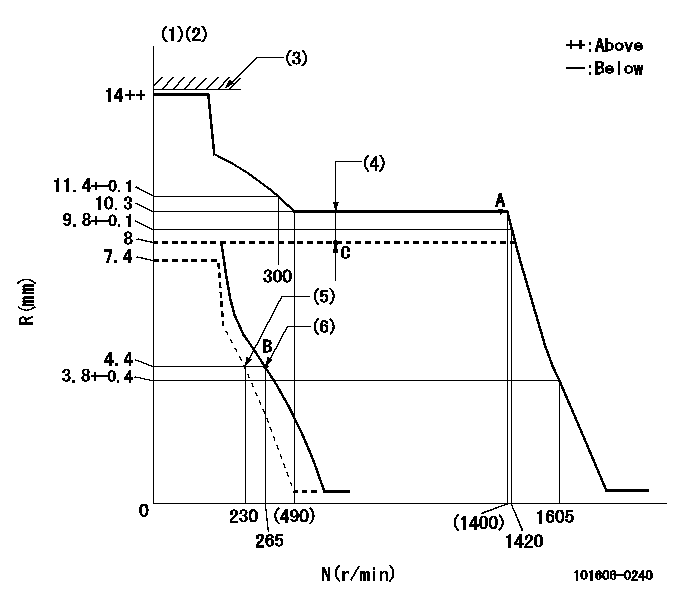
N:Pump speed
R:Rack position (mm)
(1)Target notch: K
(2)Tolerance for racks not indicated: +-0.05mm.
(3)Supply with excess fuel lever not operating.
(4)Boost compensator stroke: BCL
(5)Set idle sub-spring
(6)Main spring setting
----------
K=14 BCL=(2.3)mm
----------
----------
K=14 BCL=(2.3)mm
----------
Speed control lever angle
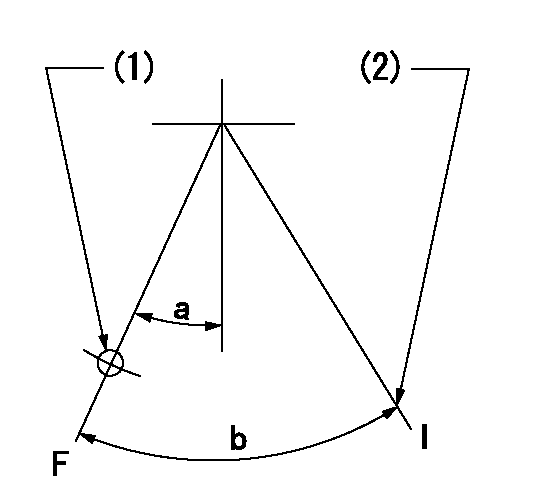
F:Full speed
I:Idle
(1)Use the hole at R = aa
(2)Stopper bolt setting
----------
aa=70mm
----------
a=(28deg)+-5deg b=(33deg)+-5deg
----------
aa=70mm
----------
a=(28deg)+-5deg b=(33deg)+-5deg
Stop lever angle
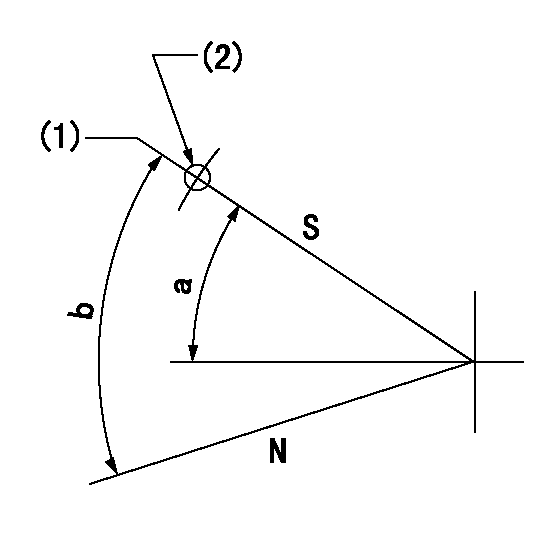
N:Pump normal
S:Stop the pump.
(1)Rack position = aa, speed = bb (stamp at delivery)
(2)Use the hole above R = cc
----------
aa=1-0.5mm bb=0r/min cc=40mm
----------
a=32deg+-5deg b=(55deg)
----------
aa=1-0.5mm bb=0r/min cc=40mm
----------
a=32deg+-5deg b=(55deg)
0000001101
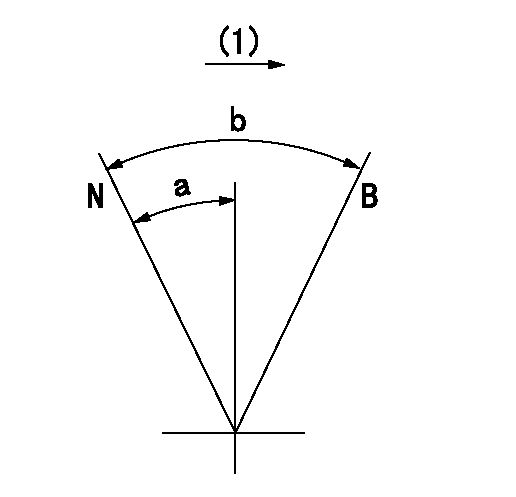
N:Normal
B:When boosted
(1)Drive side
----------
----------
a=(15deg) b=(30deg)+-5deg
----------
----------
a=(15deg) b=(30deg)+-5deg
Timing setting

(1)Pump vertical direction
(2)Positions of coupling's threaded installation holes at No 1 cylinder's beginning of injection
(3)B.T.D.C.: aa
(4)-
----------
aa=11deg
----------
a=(60deg)
----------
aa=11deg
----------
a=(60deg)
Information:
Your truck/engine may not have the same or all of the gauges as shown in the illustrations. The illustrations shown are of typical gauges. Gauges provide a "look" inside the engine. Be sure they are in good working order. You can determine what is the "normal" operating range by observing your gauges over a period of time. Noticeable changes in gauge readings are an indication of potential gauge or engine problems. This also applies to gauge readings that have changed significantly but are still within specifications. The cause of any sudden or significant change in the readings should be determined and corrected. Contact your Caterpillar dealer for assistance as needed.
If no oil pressure is indicated, stop the engine. Engine damage can result.
Oil Pressure - Typical oil pressure range is 40 and 88 psi (275 and 606 kPa) (running at rated engine speed, with SAE 10W-30 oil, at operating temperature.) A lower pressure is normal at low idle.The CHECK ENGINE lamp will illuminate (ON) and a diagnostic code will be logged in the Electronic system if oil pressure drops below 5 psi (35 kPa) at low idle rpm. Water Temperature - Typical water temperature range is 175° to 205°F (79° to 98°C). Maximum allowable temperature is 210°F (99°C) with the cooling system pressurized. Somewhat higher temperatures may occur under certain conditions. Ammeter - Indicates the amount of charge or discharge in the battery charging circuit. Typical operation of the indicator should be slightly to the positive (right) side of "0" (zero).
Do not exceed 2300 rpm in any situation or 2100 rpm if equipped with an auxiliary engine brake system.
Tachometer - Indicates engine rpm (speed). The engine can be operated at high idle without damage, but should not be allowed to overspeed. Overspeeding when downshifting, going downhill, etc., can result in serious damage to your engine. Engine Oil Temperature - Indicates engine oil temperature. Maximum oil temperature at rated speed with a full load is 220°F (104°C).The purpose of engine oil is to lubricate bearings and all internal moving parts and to cool the pistons. The oil cooler transfers heat from the oil to the engine jacket water.If the engine cooling system cannot remove the heat from the jacket water, the oil will not be properly cooled. Higher than normal oil temperature indicates a heat problem has occurred in the lubrication and/or cooling system. This can damage the cylinder heads, liners, pistons and crankshaft bearings. Fuel Level - Indicates fuel level in the fuel tank. Electrically operated, it registers only when the key switch is ON. Fuel Pressure - Indicates fuel pressure to the injection pump. The indicator should register in the NORMAL (green) range. Minimum fuel pressure is 23 psi (160 kPa) when equipped with a numerical gauge and the engine is under load. A drop in fuel pressure usually indicates a dirty or plugged fuel filter. Service Hour Meter - Indicates the total number of clock hours the engine has operated.
If no oil pressure is indicated, stop the engine. Engine damage can result.
Oil Pressure - Typical oil pressure range is 40 and 88 psi (275 and 606 kPa) (running at rated engine speed, with SAE 10W-30 oil, at operating temperature.) A lower pressure is normal at low idle.The CHECK ENGINE lamp will illuminate (ON) and a diagnostic code will be logged in the Electronic system if oil pressure drops below 5 psi (35 kPa) at low idle rpm. Water Temperature - Typical water temperature range is 175° to 205°F (79° to 98°C). Maximum allowable temperature is 210°F (99°C) with the cooling system pressurized. Somewhat higher temperatures may occur under certain conditions. Ammeter - Indicates the amount of charge or discharge in the battery charging circuit. Typical operation of the indicator should be slightly to the positive (right) side of "0" (zero).
Do not exceed 2300 rpm in any situation or 2100 rpm if equipped with an auxiliary engine brake system.
Tachometer - Indicates engine rpm (speed). The engine can be operated at high idle without damage, but should not be allowed to overspeed. Overspeeding when downshifting, going downhill, etc., can result in serious damage to your engine. Engine Oil Temperature - Indicates engine oil temperature. Maximum oil temperature at rated speed with a full load is 220°F (104°C).The purpose of engine oil is to lubricate bearings and all internal moving parts and to cool the pistons. The oil cooler transfers heat from the oil to the engine jacket water.If the engine cooling system cannot remove the heat from the jacket water, the oil will not be properly cooled. Higher than normal oil temperature indicates a heat problem has occurred in the lubrication and/or cooling system. This can damage the cylinder heads, liners, pistons and crankshaft bearings. Fuel Level - Indicates fuel level in the fuel tank. Electrically operated, it registers only when the key switch is ON. Fuel Pressure - Indicates fuel pressure to the injection pump. The indicator should register in the NORMAL (green) range. Minimum fuel pressure is 23 psi (160 kPa) when equipped with a numerical gauge and the engine is under load. A drop in fuel pressure usually indicates a dirty or plugged fuel filter. Service Hour Meter - Indicates the total number of clock hours the engine has operated.